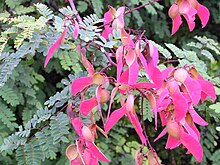Pterolobium hexapetalum
| Pterolobium hexapetalum | |
|---|---|

| |
| In India | |
| Scientific classification | |
| Kingdom: | Plantae |
| Clade: | Tracheophytes |
| Clade: | Angiosperms |
| Clade: | Eudicots |
| Clade: | Rosids |
| Order: | Fabales |
| Family: | Fabaceae |
| Subfamily: | Caesalpinioideae |
| Genus: | Pterolobium |
| Species: | P. hexapetalum |
| Binomial name | |
| Pterolobium hexapetalum | |
| Synonyms | |
Pterolobium hexapetalum, the Indian redwing, camp siege or bhoca,[1] is a flowering plant in the legume family, Fabaceae. It is found from Burma, Bhutan and Bangladesh to southern India, where it occurs up to 1200 m altitude. They are large scrambling or climbing shrubs that grow commonly in dry deciduous forest, or as pioneer plants in open land.
They carry pairs of thorns below the rachis of their bipinnate leaves, and their sprawling twigs are armed with recurved thorns. In springtime their profuse and attractive inflorescences of pinkish white flowers form a mat on tree canopies. Starting March to April, they present a major source of nectar and pollen, and are foraged on by different species of honey bee. In late summer they bear colourful samaroid fruit, containing one seed each. The young shoots are useful as cattle fodder.
References
- ^ From the Irula language in the Nilgiris
External links
 Media related to Pterolobium hexapetalum at Wikimedia Commons
Media related to Pterolobium hexapetalum at Wikimedia Commons Data related to Pterolobium hexapetalum at Wikispecies
Data related to Pterolobium hexapetalum at Wikispecies- Indian Redwing, Flowers of India
- P. hexapetalum Archived 2016-03-04 at the Wayback Machine, Flora of Nilgiri Biosphere
- Bhoca, a bee forage plant, Bees for Development Journal
- Range and synonyms: Pterolobium hexapetalum, LegumeWeb, from ILDIS World Database of Legumes
